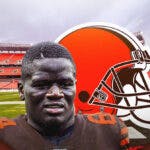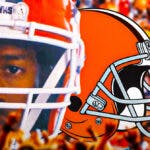The 2018 offseason was one to remember for Cleveland Browns fans. The team added Carlos Hyde, Jarvis Landry, Damarious Randall, and Tyrod Taylor through free agency and trades. Not only that, but added impact players like Denzel Ward, Nick Chubb, Antonio Callaway, and Genard Avery in the Draft, along with their franchise QB Baker Mayfield.
And yet, the 2019 offseason may have been even better. Morgan Burnett, Olivier Vernon, Sheldon Richardson, and Odell Beckham Jr make up this year's class of additions, and general manager John Dorsey was able to snag LSU cornerback Greedy Williams and Alabama linebacker Mack Wilson well past where they were projected to go.
The Browns have one of, of not the most talented roster in the entire NFL, and are finally in a position to compete for a playoff berth, and possibly more. It's been a long and difficult journey, but ultimate destination is in sight.
Since their return in 1999, the Browns had been the manifestation of perpetual disappointment. Year after year, a new regime would be brought in, the on-field product would be poor, and the cycle would be repeated. Cleveland was consistently bad, but never quite bad enough to have their choice of the top quarterback prospects.
They famously took Brady Quinn, Brandon Weeden, and Johnny Manziel all at pick #22. The team got off to a 7-4 start and was on track to make the playoffs for the first time since 2002, but dropped the last five games. The next year, the Browns went 3-13 and head coach Mike Pettine, the franchise's eighth since 199, was fired.
Owner Jimmy Haslam wanted to try something different, out of necessity. He promoted Sashi Brown, a business lawyer, to Vice President of Player Personnel, and hired Paul DePodesta as Chief Strategy Officer. DePodesta, along with Billy Beane, was the architect of the Oakland Athletics' “Moneyball” revolution in baseball, and later worked for the New York Mets.
The hiring of Brown and DePodesta signaled a radical shift in philosophy, and the NFL was about to see something completely new. This analytics-based approach was a risk, and many dismissed the group, using insults like “the Harvard nerds” and claiming that analytics could never work in the NFL, ignoring the fact that most teams were already heavily relying upon them.
Sam Hinkie is a polarizing figure among NBA fans and pundits because of his team-building strategy he employed with the Philadelphia 76ers. From 2012-2013 to 2016-2017, the Sixers never won more than 34 games, including three straight seasons with fewer than 20 wins. The NBA has since implemented anti-tanking rules, and has even changed how the Draft Lottery works in order to dissuade teams from attempting to replicate the 76ers' strategy.
Hinkie's plan earned the team plenty of high draft selections, although a few of them were spent on busts. Hinkie didn't end up being able to use the entire treasure trove of assets he had acquired, but he had laid the groundwork for future success.
Since Hinkie's departure, Philadelphia has been able to acquire two more All-Stars in Jimmy Butler and Tobias Harris, to go along with their young duo of Ben Simmons and Joel Embiid. Nerlens Noel, Jahlil Okafor, and Markelle Fultz are high picks who didn't pan out, but overall, it's impossible to argue with the results of Hinkie's work. Philly has won more than 50 games in each of the past two seasons, and are now an Eastern Conference powerhouse.
But enough about basketball. Brown and DePodesta took notice of Hinkie's strategy in the NBA, and brought many of its aspects to the NFL. Shortly after being hired, Brown stated in a press conference that he believed he could not outsmart the Draft, and that in order to maximize his chances of finding good players, he would acquire as many selections as he possibly could, even trading for Brock Osweiler's albatross of a contract in exchange for a second-rounder.
He ran two Drafts for the team, choosing 14 players in 2016 and 10 in 2017, with four of those 24 picks being first-rounders. What gave fans hope was the hiring of Hue Jackson as head coach. Cincinnati's offensive coordinator, Jackson was credited with orchestrating Andy Dalton's excellent 2015 season, in which he threw 25 touchdowns to just seven interceptions. Jackson was considered the top coach available, and wanted to bring the Browns back to prominence.
When Brown took over, Cleveland's roster was old, expensive, and bad. He quickly shed as much salary as he could, and traded away key players for future draft picks. He spent money on veterans like Kenny Britt and Kevin Zeitler, but just enough to hit the minimum spending amount, in order to maximize the amount of rollover cap that the Browns could bring with them for the future.
The 2016 and 2017 teams were stripped to the core, filled with rookies and inexperienced young players. The thought process was that if they were going to lose, and losing was the goal, they might as well try to find some diamonds in the rough, rather than playing established veterans who wouldn't be with the team in a few seasons.
This approach did find some good players. Undrafted free agent Briean Boddy-Calhoun established himself as one of the better slot CBs in the game. And reclamation project Jamar Taylor, acquired in a seventh-round pick swap with the Miami Dolphins, played very well. But overall, the team was devoid of talent, and their 1-15 record showed that. After the season, Jackson stated that “there was nowhere to go but up”, and claimed that he would jump in Lake Erie if the team went 1-15 again.
He had to jump in the lake. Despite a strong rookie class that included Myles Garrett, Jabrill Peppers, David Njoku, and Larry Ogunjobi, Cleveland became just the second team in NFL history to go winless over a season. Jackson's handling of rookie QB DeShone Kizer, who was almost universally viewed as needing another year of development in college, was woefully inept.
The playcalling was predictable and uncreative, and despite Jackson claiming that he would stick with Kizer through the ups and downs, the rookie was benched multiple times mid-game, and lost out on a start, only for his replacement, Kevin Hogan, to perform even worse. Kizer showed flashes of great play, but they were few and far between. He finished the season having scored 16 TDs, but turned the ball over a whopping 29 times.
Jackson routinely trashed his own players and coaches, and it was always someone else's fault, never his own. He and the front office never saw eye-to-eye, which was a foundation issue with the Browns at the time; both Jackson and the front office reported directly to the owner, instead of the coach to the GM, as is the case with nearly every successful organization.
While Jackson's tenure with the team was disastrous, Brown isn't faultless either. He was a master at making trades and acquiring draft picks, but he struggled to actually use them. Of the 24 players he selected, only six are still with the team, and just four are significant contributors.
To be fair, not all of the remaining 18 are bad players, and quite a few are only on new teams because current GM John Dorsey prefers to have his own guys in place, as most executives do. Of the 24, 12 can be considered at worst decent backups, so a hit rate of 50% is about in line with what Brown predicted to start.
Brown was fired towards the end of the 2017 season, because Dorsey became available. The former Green Bay Packers staffer had built a good playoff team in Kansas City, and drafted MVP Patrick Mahomes, who hadn't yet taken over the starting job at that point. Dorsey quickly began to change things around, as the entire roster was churned, with just 19 out of the 53 on opening day of 2018 having been with the team for the final game of 2017.
After his flurry of trades, Dorsey ended up with nine selections in the 2018 Draft, including two of the top five, and three in the second round. Six of those are expected to play major roles this season, and that number would be seven if pass-rusher Chad Thomas can begin to reach his immense potential.
For the first time since 2015, Cleveland didn't trade down in the first round, and Dorsey made his top picks count. Brown was like an airplane mechanic, building a powerful machine, but without Dorsey piloting it, everything could have gone to waste.
Now, with the Pittsburgh Steelers looking completely beatable, and the Kansas City Chiefs unexpectedly losing many of their top players, the Browns have a chance to ascend to the NFL's elite. It didn't end up being a full commitment, but the Browns Trusted The Process just enough to reap its benefits. Dorsey is acquiring talent, and DePodesta is still in the building, likely making sure Dorsey doesn't repeat his mistakes with the salary cap that got him fired in KC.
Cleveland already has the second-highest payroll in the NFL, and are about $15 million over the salary cap, but still have $23 million in cap space, thanks to the rollover that Brown saved up. With reports that the team is looking into trading for Buccaneers' DT Gerald McCoy, it appears as if the Browns are truly all-in, but also focused on creating a sustainable contender.
What was the ultimate goal of The Process? To create a team built to succeed in the modern NFL that is economically feasible to keep together long-term. With how incredibly talented Cleveland is at key positions, it's safe to say things worked out, at long last. Obviously the Browns have proven nothing yet, but that will come in time. The Cleveland Browns are finally back.




